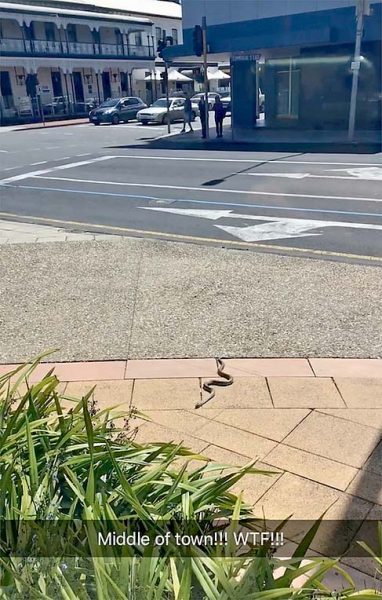

A VETERAN Mount Gambier reptile catcher has issued a fresh warning to residents to be vigilant following a snake dropping from a car in the heart of the city this week.

The one-metre long snake fell from a vehicle near the central traffic lights and slithered across to the Main Corner building before disappearing into nearby gardens.
This unusual incident follows a number of snake sightings across the Mount Gambier district, including near Tension Woods College and at the Crater Lakes precinct.
Mount Gambier City Council worker Rowan Thurlings – who was at the Main Corner on Sunday – said he did not initially believe a tourist’s claim that a snake was outside the prominent inner-city building.
“I served someone at the Main Corner and they left, but they came back in and said ‘it is like someone opened their car door and a snake fell out’,” Mr Thurlings said.
“I thought he was joking, but I looked over at the road and I saw the snake and thought it had to be fake, but it started moving.”
He said the reptile slithered up the kerb, across the footpath and vanished.
“I called a snake catcher, but he couldn’t find it,” Mr Thurlings said.
“It was quite unusual, it is not something you see every day in the middle of town.”
Mr Thurlings – who posted a video of the suspected brown snake on social media – said he did not expect it to be so popular with more than 20,000 views.
He said he was unsure whether someone found the snake in their car and threw it out or it fell from underneath the vehicle.
Licensed snake catcher David Miles warned yesterday highly venomous snakes would be now on the move around the Mount Gambier district.
Mr Miles – who was called to the Main Corner to locate the snake – revealed it was not uncommon for snakes to drop from cars.
“If you run over a snake, they can flick up and get under the car,” the veteran snake handler said.
Alternatively, he said the reptiles slithered up underneath cars to seek warmth.
“Snakes can be found across the city, they are known to crawl through drains and gutters,” Mr Miles explained.
Mr Miles has also recently been called out to a residents’ garage near Mount Gambier after discovering a snake.
The snake handler urged residents to be particularly watchful walking in the Crater Lakes precinct, which was home to lowlands copperheads.
“People need to be mindful there are venomous snakes in this area and should always carry a mobile phone and bandages,” he said.
He also called on people to be careful in coastal scrub near beaches, which were often a haven for snakes, and never to interfere with them.
“If you don’t interfere with them, then you won’t get bitten. People should also not touch snakes if they think they are dead, often they are just bathing in the sun,” he said.
He urged people who found snakes in public areas or homes to contact licensed snake catchers and not handle the reptile themselves.
“When I handle a snake, I am always mindful they can kill me,” Mr Miles said.
He said the Limestone Coast was home to copperheads, tiger and brown snakes, which were highly venomous.
Mr Miles warned copperheads had the same toxicity as an Indian cobra.
His comments also follow the Royal Flying Doctor Service updating its advice for people bitten by a snake following a comprehensive study of more than 1500 patients.
The study found the brown snake was the most common biter and three-quarters of the people bitten are males aged in their thirties.
Half of all bites occurred while people were out walking, with gardening and trying to catch a snake the most common other scenarios.
The new study has prompted the flying doctor to reverse previous long-standing advice about the importance of identifying the colour and type of snake.
“Staying in the area after an attack can be dangerous and recent advances in medication mean we can now treat any snakebite with a generic polyvalent anti-venom, so identification is no longer necessary,” senior flight nurse Tracey King said.
There are 3000 reported snake bites across Australia each year, with an average of two fatalities.









